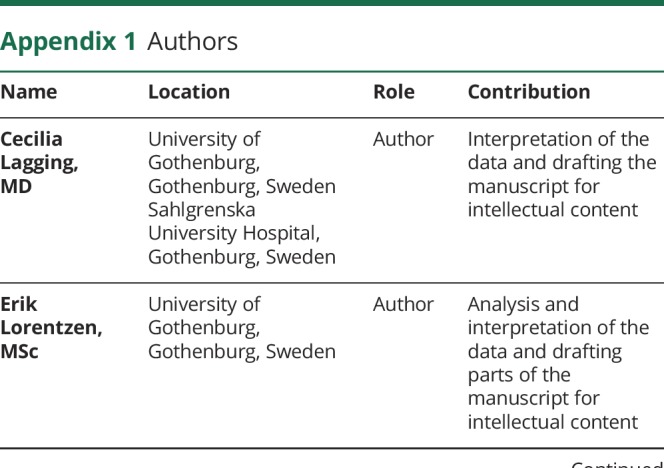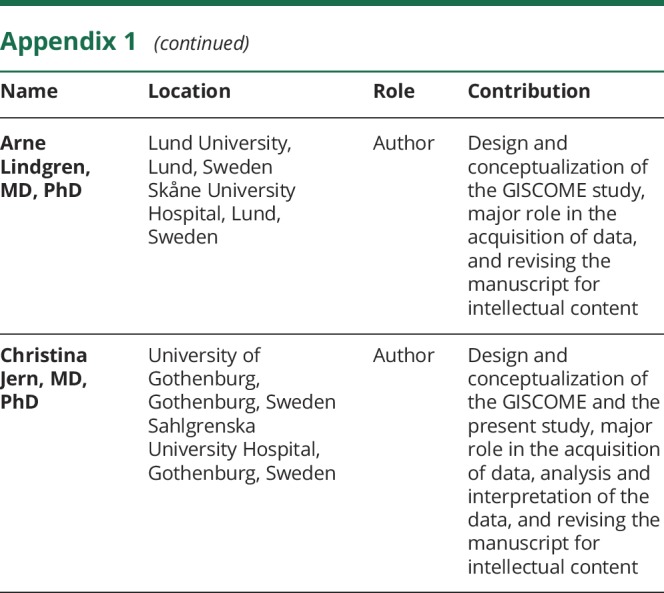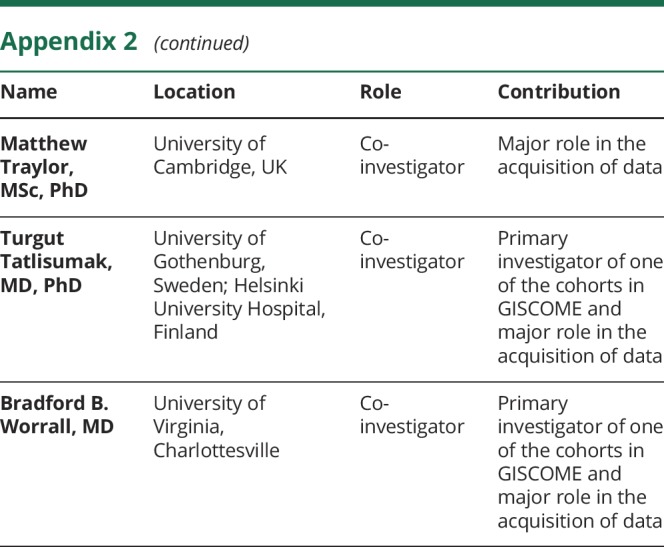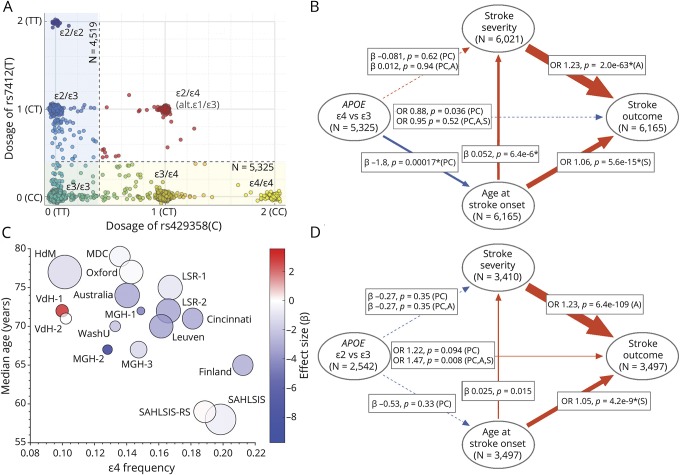Cecilia Lagging
Cecilia Lagging, MD
1From the Department of Laboratory Medicine (C.L., T.M.S., A.P., C.J.), Institute of Biomedicine, the Sahlgrenska Academy, University of Gothenburg, Gothenburg, Sweden; Department of Clinical Genetics and Genomics (C.L., A.P., C.J.), Sahlgrenska University Hospital, Gothenburg, Sweden; Bioinformatics Core Facility (E.L.), University of Gothenburg, Sweden; Department of Clinical Sciences Lund (M.S., A.L.), Neurology, Lund University, Sweden; Department of Neurology and Rehabilitation Medicine (M.S.), Neurology, Skåne University Hospital, Malmö, Sweden; Department of Neurology (J.W.C.), Baltimore VA Medical Center and University of Maryland School of Medicine, Baltimore, MD; Department of Neurology (K.J.), Sahlgrenska University Hospital, Gothenburg, Sweden; Department of Clinical Neuroscience (K.J.), Institute of Neuroscience and Physiology, the Sahlgrenska Academy University of Gothenburg, Sweden; Neurosciences (R.L.), Experimental Neurology, KU Leuven—University of Leuven; VIB—Center for Brain & Disease Research (R.L.); Department of Neurology (R.L.), University Hospitals Leuven, Belgium; Department of Neurology (C.-L.P.), Washington University School of Medicine in St. Louis; J. Philip Kistler Stroke Research Center (N.S.R.), Department of Neurology, Massachusetts General Hospital, Harvard Medical School, Boston; Stroke Division (V.T.), Florey Institute of Neuroscience and Mental Health, University of Melbourne, Heidelberg, Victoria, Australia; Department of Neurology (V.T.), Austin Health, Heidelberg, Victoria, Australia; Department of Neurology and Rehabilitation (D.W.), University of Cincinnati College of Medicine, OH; Faculty of Health (J.M.M.), University of Technology Sydney, Sydney, Australia; Hunter Medical Research Centre (J.M.M.), Newcastle, Australia; and Department of Neurology and Rehabilitation Medicine (A.L.), Neurology, Skåne University Hospital, Lund, Sweden.
1,✉,
Erik Lorentzen
Erik Lorentzen, MSc
1From the Department of Laboratory Medicine (C.L., T.M.S., A.P., C.J.), Institute of Biomedicine, the Sahlgrenska Academy, University of Gothenburg, Gothenburg, Sweden; Department of Clinical Genetics and Genomics (C.L., A.P., C.J.), Sahlgrenska University Hospital, Gothenburg, Sweden; Bioinformatics Core Facility (E.L.), University of Gothenburg, Sweden; Department of Clinical Sciences Lund (M.S., A.L.), Neurology, Lund University, Sweden; Department of Neurology and Rehabilitation Medicine (M.S.), Neurology, Skåne University Hospital, Malmö, Sweden; Department of Neurology (J.W.C.), Baltimore VA Medical Center and University of Maryland School of Medicine, Baltimore, MD; Department of Neurology (K.J.), Sahlgrenska University Hospital, Gothenburg, Sweden; Department of Clinical Neuroscience (K.J.), Institute of Neuroscience and Physiology, the Sahlgrenska Academy University of Gothenburg, Sweden; Neurosciences (R.L.), Experimental Neurology, KU Leuven—University of Leuven; VIB—Center for Brain & Disease Research (R.L.); Department of Neurology (R.L.), University Hospitals Leuven, Belgium; Department of Neurology (C.-L.P.), Washington University School of Medicine in St. Louis; J. Philip Kistler Stroke Research Center (N.S.R.), Department of Neurology, Massachusetts General Hospital, Harvard Medical School, Boston; Stroke Division (V.T.), Florey Institute of Neuroscience and Mental Health, University of Melbourne, Heidelberg, Victoria, Australia; Department of Neurology (V.T.), Austin Health, Heidelberg, Victoria, Australia; Department of Neurology and Rehabilitation (D.W.), University of Cincinnati College of Medicine, OH; Faculty of Health (J.M.M.), University of Technology Sydney, Sydney, Australia; Hunter Medical Research Centre (J.M.M.), Newcastle, Australia; and Department of Neurology and Rehabilitation Medicine (A.L.), Neurology, Skåne University Hospital, Lund, Sweden.
1,
Tara M Stanne
Tara M Stanne, PhD
1From the Department of Laboratory Medicine (C.L., T.M.S., A.P., C.J.), Institute of Biomedicine, the Sahlgrenska Academy, University of Gothenburg, Gothenburg, Sweden; Department of Clinical Genetics and Genomics (C.L., A.P., C.J.), Sahlgrenska University Hospital, Gothenburg, Sweden; Bioinformatics Core Facility (E.L.), University of Gothenburg, Sweden; Department of Clinical Sciences Lund (M.S., A.L.), Neurology, Lund University, Sweden; Department of Neurology and Rehabilitation Medicine (M.S.), Neurology, Skåne University Hospital, Malmö, Sweden; Department of Neurology (J.W.C.), Baltimore VA Medical Center and University of Maryland School of Medicine, Baltimore, MD; Department of Neurology (K.J.), Sahlgrenska University Hospital, Gothenburg, Sweden; Department of Clinical Neuroscience (K.J.), Institute of Neuroscience and Physiology, the Sahlgrenska Academy University of Gothenburg, Sweden; Neurosciences (R.L.), Experimental Neurology, KU Leuven—University of Leuven; VIB—Center for Brain & Disease Research (R.L.); Department of Neurology (R.L.), University Hospitals Leuven, Belgium; Department of Neurology (C.-L.P.), Washington University School of Medicine in St. Louis; J. Philip Kistler Stroke Research Center (N.S.R.), Department of Neurology, Massachusetts General Hospital, Harvard Medical School, Boston; Stroke Division (V.T.), Florey Institute of Neuroscience and Mental Health, University of Melbourne, Heidelberg, Victoria, Australia; Department of Neurology (V.T.), Austin Health, Heidelberg, Victoria, Australia; Department of Neurology and Rehabilitation (D.W.), University of Cincinnati College of Medicine, OH; Faculty of Health (J.M.M.), University of Technology Sydney, Sydney, Australia; Hunter Medical Research Centre (J.M.M.), Newcastle, Australia; and Department of Neurology and Rehabilitation Medicine (A.L.), Neurology, Skåne University Hospital, Lund, Sweden.
1,
Annie Pedersen
Annie Pedersen, MD, PhD
1From the Department of Laboratory Medicine (C.L., T.M.S., A.P., C.J.), Institute of Biomedicine, the Sahlgrenska Academy, University of Gothenburg, Gothenburg, Sweden; Department of Clinical Genetics and Genomics (C.L., A.P., C.J.), Sahlgrenska University Hospital, Gothenburg, Sweden; Bioinformatics Core Facility (E.L.), University of Gothenburg, Sweden; Department of Clinical Sciences Lund (M.S., A.L.), Neurology, Lund University, Sweden; Department of Neurology and Rehabilitation Medicine (M.S.), Neurology, Skåne University Hospital, Malmö, Sweden; Department of Neurology (J.W.C.), Baltimore VA Medical Center and University of Maryland School of Medicine, Baltimore, MD; Department of Neurology (K.J.), Sahlgrenska University Hospital, Gothenburg, Sweden; Department of Clinical Neuroscience (K.J.), Institute of Neuroscience and Physiology, the Sahlgrenska Academy University of Gothenburg, Sweden; Neurosciences (R.L.), Experimental Neurology, KU Leuven—University of Leuven; VIB—Center for Brain & Disease Research (R.L.); Department of Neurology (R.L.), University Hospitals Leuven, Belgium; Department of Neurology (C.-L.P.), Washington University School of Medicine in St. Louis; J. Philip Kistler Stroke Research Center (N.S.R.), Department of Neurology, Massachusetts General Hospital, Harvard Medical School, Boston; Stroke Division (V.T.), Florey Institute of Neuroscience and Mental Health, University of Melbourne, Heidelberg, Victoria, Australia; Department of Neurology (V.T.), Austin Health, Heidelberg, Victoria, Australia; Department of Neurology and Rehabilitation (D.W.), University of Cincinnati College of Medicine, OH; Faculty of Health (J.M.M.), University of Technology Sydney, Sydney, Australia; Hunter Medical Research Centre (J.M.M.), Newcastle, Australia; and Department of Neurology and Rehabilitation Medicine (A.L.), Neurology, Skåne University Hospital, Lund, Sweden.
1,
Martin Söderholm
Martin Söderholm, MD, PhD
1From the Department of Laboratory Medicine (C.L., T.M.S., A.P., C.J.), Institute of Biomedicine, the Sahlgrenska Academy, University of Gothenburg, Gothenburg, Sweden; Department of Clinical Genetics and Genomics (C.L., A.P., C.J.), Sahlgrenska University Hospital, Gothenburg, Sweden; Bioinformatics Core Facility (E.L.), University of Gothenburg, Sweden; Department of Clinical Sciences Lund (M.S., A.L.), Neurology, Lund University, Sweden; Department of Neurology and Rehabilitation Medicine (M.S.), Neurology, Skåne University Hospital, Malmö, Sweden; Department of Neurology (J.W.C.), Baltimore VA Medical Center and University of Maryland School of Medicine, Baltimore, MD; Department of Neurology (K.J.), Sahlgrenska University Hospital, Gothenburg, Sweden; Department of Clinical Neuroscience (K.J.), Institute of Neuroscience and Physiology, the Sahlgrenska Academy University of Gothenburg, Sweden; Neurosciences (R.L.), Experimental Neurology, KU Leuven—University of Leuven; VIB—Center for Brain & Disease Research (R.L.); Department of Neurology (R.L.), University Hospitals Leuven, Belgium; Department of Neurology (C.-L.P.), Washington University School of Medicine in St. Louis; J. Philip Kistler Stroke Research Center (N.S.R.), Department of Neurology, Massachusetts General Hospital, Harvard Medical School, Boston; Stroke Division (V.T.), Florey Institute of Neuroscience and Mental Health, University of Melbourne, Heidelberg, Victoria, Australia; Department of Neurology (V.T.), Austin Health, Heidelberg, Victoria, Australia; Department of Neurology and Rehabilitation (D.W.), University of Cincinnati College of Medicine, OH; Faculty of Health (J.M.M.), University of Technology Sydney, Sydney, Australia; Hunter Medical Research Centre (J.M.M.), Newcastle, Australia; and Department of Neurology and Rehabilitation Medicine (A.L.), Neurology, Skåne University Hospital, Lund, Sweden.
1,
John W Cole
John W Cole, MD, MSc
1From the Department of Laboratory Medicine (C.L., T.M.S., A.P., C.J.), Institute of Biomedicine, the Sahlgrenska Academy, University of Gothenburg, Gothenburg, Sweden; Department of Clinical Genetics and Genomics (C.L., A.P., C.J.), Sahlgrenska University Hospital, Gothenburg, Sweden; Bioinformatics Core Facility (E.L.), University of Gothenburg, Sweden; Department of Clinical Sciences Lund (M.S., A.L.), Neurology, Lund University, Sweden; Department of Neurology and Rehabilitation Medicine (M.S.), Neurology, Skåne University Hospital, Malmö, Sweden; Department of Neurology (J.W.C.), Baltimore VA Medical Center and University of Maryland School of Medicine, Baltimore, MD; Department of Neurology (K.J.), Sahlgrenska University Hospital, Gothenburg, Sweden; Department of Clinical Neuroscience (K.J.), Institute of Neuroscience and Physiology, the Sahlgrenska Academy University of Gothenburg, Sweden; Neurosciences (R.L.), Experimental Neurology, KU Leuven—University of Leuven; VIB—Center for Brain & Disease Research (R.L.); Department of Neurology (R.L.), University Hospitals Leuven, Belgium; Department of Neurology (C.-L.P.), Washington University School of Medicine in St. Louis; J. Philip Kistler Stroke Research Center (N.S.R.), Department of Neurology, Massachusetts General Hospital, Harvard Medical School, Boston; Stroke Division (V.T.), Florey Institute of Neuroscience and Mental Health, University of Melbourne, Heidelberg, Victoria, Australia; Department of Neurology (V.T.), Austin Health, Heidelberg, Victoria, Australia; Department of Neurology and Rehabilitation (D.W.), University of Cincinnati College of Medicine, OH; Faculty of Health (J.M.M.), University of Technology Sydney, Sydney, Australia; Hunter Medical Research Centre (J.M.M.), Newcastle, Australia; and Department of Neurology and Rehabilitation Medicine (A.L.), Neurology, Skåne University Hospital, Lund, Sweden.
1,
Katarina Jood
Katarina Jood, MD, PhD
1From the Department of Laboratory Medicine (C.L., T.M.S., A.P., C.J.), Institute of Biomedicine, the Sahlgrenska Academy, University of Gothenburg, Gothenburg, Sweden; Department of Clinical Genetics and Genomics (C.L., A.P., C.J.), Sahlgrenska University Hospital, Gothenburg, Sweden; Bioinformatics Core Facility (E.L.), University of Gothenburg, Sweden; Department of Clinical Sciences Lund (M.S., A.L.), Neurology, Lund University, Sweden; Department of Neurology and Rehabilitation Medicine (M.S.), Neurology, Skåne University Hospital, Malmö, Sweden; Department of Neurology (J.W.C.), Baltimore VA Medical Center and University of Maryland School of Medicine, Baltimore, MD; Department of Neurology (K.J.), Sahlgrenska University Hospital, Gothenburg, Sweden; Department of Clinical Neuroscience (K.J.), Institute of Neuroscience and Physiology, the Sahlgrenska Academy University of Gothenburg, Sweden; Neurosciences (R.L.), Experimental Neurology, KU Leuven—University of Leuven; VIB—Center for Brain & Disease Research (R.L.); Department of Neurology (R.L.), University Hospitals Leuven, Belgium; Department of Neurology (C.-L.P.), Washington University School of Medicine in St. Louis; J. Philip Kistler Stroke Research Center (N.S.R.), Department of Neurology, Massachusetts General Hospital, Harvard Medical School, Boston; Stroke Division (V.T.), Florey Institute of Neuroscience and Mental Health, University of Melbourne, Heidelberg, Victoria, Australia; Department of Neurology (V.T.), Austin Health, Heidelberg, Victoria, Australia; Department of Neurology and Rehabilitation (D.W.), University of Cincinnati College of Medicine, OH; Faculty of Health (J.M.M.), University of Technology Sydney, Sydney, Australia; Hunter Medical Research Centre (J.M.M.), Newcastle, Australia; and Department of Neurology and Rehabilitation Medicine (A.L.), Neurology, Skåne University Hospital, Lund, Sweden.
1,
Robin Lemmens
Robin Lemmens, MD, PhD
1From the Department of Laboratory Medicine (C.L., T.M.S., A.P., C.J.), Institute of Biomedicine, the Sahlgrenska Academy, University of Gothenburg, Gothenburg, Sweden; Department of Clinical Genetics and Genomics (C.L., A.P., C.J.), Sahlgrenska University Hospital, Gothenburg, Sweden; Bioinformatics Core Facility (E.L.), University of Gothenburg, Sweden; Department of Clinical Sciences Lund (M.S., A.L.), Neurology, Lund University, Sweden; Department of Neurology and Rehabilitation Medicine (M.S.), Neurology, Skåne University Hospital, Malmö, Sweden; Department of Neurology (J.W.C.), Baltimore VA Medical Center and University of Maryland School of Medicine, Baltimore, MD; Department of Neurology (K.J.), Sahlgrenska University Hospital, Gothenburg, Sweden; Department of Clinical Neuroscience (K.J.), Institute of Neuroscience and Physiology, the Sahlgrenska Academy University of Gothenburg, Sweden; Neurosciences (R.L.), Experimental Neurology, KU Leuven—University of Leuven; VIB—Center for Brain & Disease Research (R.L.); Department of Neurology (R.L.), University Hospitals Leuven, Belgium; Department of Neurology (C.-L.P.), Washington University School of Medicine in St. Louis; J. Philip Kistler Stroke Research Center (N.S.R.), Department of Neurology, Massachusetts General Hospital, Harvard Medical School, Boston; Stroke Division (V.T.), Florey Institute of Neuroscience and Mental Health, University of Melbourne, Heidelberg, Victoria, Australia; Department of Neurology (V.T.), Austin Health, Heidelberg, Victoria, Australia; Department of Neurology and Rehabilitation (D.W.), University of Cincinnati College of Medicine, OH; Faculty of Health (J.M.M.), University of Technology Sydney, Sydney, Australia; Hunter Medical Research Centre (J.M.M.), Newcastle, Australia; and Department of Neurology and Rehabilitation Medicine (A.L.), Neurology, Skåne University Hospital, Lund, Sweden.
1,
Chia-Ling Phuah
Chia-Ling Phuah, MD, MMSc
1From the Department of Laboratory Medicine (C.L., T.M.S., A.P., C.J.), Institute of Biomedicine, the Sahlgrenska Academy, University of Gothenburg, Gothenburg, Sweden; Department of Clinical Genetics and Genomics (C.L., A.P., C.J.), Sahlgrenska University Hospital, Gothenburg, Sweden; Bioinformatics Core Facility (E.L.), University of Gothenburg, Sweden; Department of Clinical Sciences Lund (M.S., A.L.), Neurology, Lund University, Sweden; Department of Neurology and Rehabilitation Medicine (M.S.), Neurology, Skåne University Hospital, Malmö, Sweden; Department of Neurology (J.W.C.), Baltimore VA Medical Center and University of Maryland School of Medicine, Baltimore, MD; Department of Neurology (K.J.), Sahlgrenska University Hospital, Gothenburg, Sweden; Department of Clinical Neuroscience (K.J.), Institute of Neuroscience and Physiology, the Sahlgrenska Academy University of Gothenburg, Sweden; Neurosciences (R.L.), Experimental Neurology, KU Leuven—University of Leuven; VIB—Center for Brain & Disease Research (R.L.); Department of Neurology (R.L.), University Hospitals Leuven, Belgium; Department of Neurology (C.-L.P.), Washington University School of Medicine in St. Louis; J. Philip Kistler Stroke Research Center (N.S.R.), Department of Neurology, Massachusetts General Hospital, Harvard Medical School, Boston; Stroke Division (V.T.), Florey Institute of Neuroscience and Mental Health, University of Melbourne, Heidelberg, Victoria, Australia; Department of Neurology (V.T.), Austin Health, Heidelberg, Victoria, Australia; Department of Neurology and Rehabilitation (D.W.), University of Cincinnati College of Medicine, OH; Faculty of Health (J.M.M.), University of Technology Sydney, Sydney, Australia; Hunter Medical Research Centre (J.M.M.), Newcastle, Australia; and Department of Neurology and Rehabilitation Medicine (A.L.), Neurology, Skåne University Hospital, Lund, Sweden.
1,
Natalia S Rost
Natalia S Rost, MD, MPH
1From the Department of Laboratory Medicine (C.L., T.M.S., A.P., C.J.), Institute of Biomedicine, the Sahlgrenska Academy, University of Gothenburg, Gothenburg, Sweden; Department of Clinical Genetics and Genomics (C.L., A.P., C.J.), Sahlgrenska University Hospital, Gothenburg, Sweden; Bioinformatics Core Facility (E.L.), University of Gothenburg, Sweden; Department of Clinical Sciences Lund (M.S., A.L.), Neurology, Lund University, Sweden; Department of Neurology and Rehabilitation Medicine (M.S.), Neurology, Skåne University Hospital, Malmö, Sweden; Department of Neurology (J.W.C.), Baltimore VA Medical Center and University of Maryland School of Medicine, Baltimore, MD; Department of Neurology (K.J.), Sahlgrenska University Hospital, Gothenburg, Sweden; Department of Clinical Neuroscience (K.J.), Institute of Neuroscience and Physiology, the Sahlgrenska Academy University of Gothenburg, Sweden; Neurosciences (R.L.), Experimental Neurology, KU Leuven—University of Leuven; VIB—Center for Brain & Disease Research (R.L.); Department of Neurology (R.L.), University Hospitals Leuven, Belgium; Department of Neurology (C.-L.P.), Washington University School of Medicine in St. Louis; J. Philip Kistler Stroke Research Center (N.S.R.), Department of Neurology, Massachusetts General Hospital, Harvard Medical School, Boston; Stroke Division (V.T.), Florey Institute of Neuroscience and Mental Health, University of Melbourne, Heidelberg, Victoria, Australia; Department of Neurology (V.T.), Austin Health, Heidelberg, Victoria, Australia; Department of Neurology and Rehabilitation (D.W.), University of Cincinnati College of Medicine, OH; Faculty of Health (J.M.M.), University of Technology Sydney, Sydney, Australia; Hunter Medical Research Centre (J.M.M.), Newcastle, Australia; and Department of Neurology and Rehabilitation Medicine (A.L.), Neurology, Skåne University Hospital, Lund, Sweden.
1,
Vincent Thijs
Vincent Thijs, MD, PhD
1From the Department of Laboratory Medicine (C.L., T.M.S., A.P., C.J.), Institute of Biomedicine, the Sahlgrenska Academy, University of Gothenburg, Gothenburg, Sweden; Department of Clinical Genetics and Genomics (C.L., A.P., C.J.), Sahlgrenska University Hospital, Gothenburg, Sweden; Bioinformatics Core Facility (E.L.), University of Gothenburg, Sweden; Department of Clinical Sciences Lund (M.S., A.L.), Neurology, Lund University, Sweden; Department of Neurology and Rehabilitation Medicine (M.S.), Neurology, Skåne University Hospital, Malmö, Sweden; Department of Neurology (J.W.C.), Baltimore VA Medical Center and University of Maryland School of Medicine, Baltimore, MD; Department of Neurology (K.J.), Sahlgrenska University Hospital, Gothenburg, Sweden; Department of Clinical Neuroscience (K.J.), Institute of Neuroscience and Physiology, the Sahlgrenska Academy University of Gothenburg, Sweden; Neurosciences (R.L.), Experimental Neurology, KU Leuven—University of Leuven; VIB—Center for Brain & Disease Research (R.L.); Department of Neurology (R.L.), University Hospitals Leuven, Belgium; Department of Neurology (C.-L.P.), Washington University School of Medicine in St. Louis; J. Philip Kistler Stroke Research Center (N.S.R.), Department of Neurology, Massachusetts General Hospital, Harvard Medical School, Boston; Stroke Division (V.T.), Florey Institute of Neuroscience and Mental Health, University of Melbourne, Heidelberg, Victoria, Australia; Department of Neurology (V.T.), Austin Health, Heidelberg, Victoria, Australia; Department of Neurology and Rehabilitation (D.W.), University of Cincinnati College of Medicine, OH; Faculty of Health (J.M.M.), University of Technology Sydney, Sydney, Australia; Hunter Medical Research Centre (J.M.M.), Newcastle, Australia; and Department of Neurology and Rehabilitation Medicine (A.L.), Neurology, Skåne University Hospital, Lund, Sweden.
1,
Daniel Woo
Daniel Woo, MD, MSc
1From the Department of Laboratory Medicine (C.L., T.M.S., A.P., C.J.), Institute of Biomedicine, the Sahlgrenska Academy, University of Gothenburg, Gothenburg, Sweden; Department of Clinical Genetics and Genomics (C.L., A.P., C.J.), Sahlgrenska University Hospital, Gothenburg, Sweden; Bioinformatics Core Facility (E.L.), University of Gothenburg, Sweden; Department of Clinical Sciences Lund (M.S., A.L.), Neurology, Lund University, Sweden; Department of Neurology and Rehabilitation Medicine (M.S.), Neurology, Skåne University Hospital, Malmö, Sweden; Department of Neurology (J.W.C.), Baltimore VA Medical Center and University of Maryland School of Medicine, Baltimore, MD; Department of Neurology (K.J.), Sahlgrenska University Hospital, Gothenburg, Sweden; Department of Clinical Neuroscience (K.J.), Institute of Neuroscience and Physiology, the Sahlgrenska Academy University of Gothenburg, Sweden; Neurosciences (R.L.), Experimental Neurology, KU Leuven—University of Leuven; VIB—Center for Brain & Disease Research (R.L.); Department of Neurology (R.L.), University Hospitals Leuven, Belgium; Department of Neurology (C.-L.P.), Washington University School of Medicine in St. Louis; J. Philip Kistler Stroke Research Center (N.S.R.), Department of Neurology, Massachusetts General Hospital, Harvard Medical School, Boston; Stroke Division (V.T.), Florey Institute of Neuroscience and Mental Health, University of Melbourne, Heidelberg, Victoria, Australia; Department of Neurology (V.T.), Austin Health, Heidelberg, Victoria, Australia; Department of Neurology and Rehabilitation (D.W.), University of Cincinnati College of Medicine, OH; Faculty of Health (J.M.M.), University of Technology Sydney, Sydney, Australia; Hunter Medical Research Centre (J.M.M.), Newcastle, Australia; and Department of Neurology and Rehabilitation Medicine (A.L.), Neurology, Skåne University Hospital, Lund, Sweden.
1,
Jane M Maguire
Jane M Maguire, RN, PhD
1From the Department of Laboratory Medicine (C.L., T.M.S., A.P., C.J.), Institute of Biomedicine, the Sahlgrenska Academy, University of Gothenburg, Gothenburg, Sweden; Department of Clinical Genetics and Genomics (C.L., A.P., C.J.), Sahlgrenska University Hospital, Gothenburg, Sweden; Bioinformatics Core Facility (E.L.), University of Gothenburg, Sweden; Department of Clinical Sciences Lund (M.S., A.L.), Neurology, Lund University, Sweden; Department of Neurology and Rehabilitation Medicine (M.S.), Neurology, Skåne University Hospital, Malmö, Sweden; Department of Neurology (J.W.C.), Baltimore VA Medical Center and University of Maryland School of Medicine, Baltimore, MD; Department of Neurology (K.J.), Sahlgrenska University Hospital, Gothenburg, Sweden; Department of Clinical Neuroscience (K.J.), Institute of Neuroscience and Physiology, the Sahlgrenska Academy University of Gothenburg, Sweden; Neurosciences (R.L.), Experimental Neurology, KU Leuven—University of Leuven; VIB—Center for Brain & Disease Research (R.L.); Department of Neurology (R.L.), University Hospitals Leuven, Belgium; Department of Neurology (C.-L.P.), Washington University School of Medicine in St. Louis; J. Philip Kistler Stroke Research Center (N.S.R.), Department of Neurology, Massachusetts General Hospital, Harvard Medical School, Boston; Stroke Division (V.T.), Florey Institute of Neuroscience and Mental Health, University of Melbourne, Heidelberg, Victoria, Australia; Department of Neurology (V.T.), Austin Health, Heidelberg, Victoria, Australia; Department of Neurology and Rehabilitation (D.W.), University of Cincinnati College of Medicine, OH; Faculty of Health (J.M.M.), University of Technology Sydney, Sydney, Australia; Hunter Medical Research Centre (J.M.M.), Newcastle, Australia; and Department of Neurology and Rehabilitation Medicine (A.L.), Neurology, Skåne University Hospital, Lund, Sweden.
1,
Arne Lindgren
Arne Lindgren, MD, PhD
1From the Department of Laboratory Medicine (C.L., T.M.S., A.P., C.J.), Institute of Biomedicine, the Sahlgrenska Academy, University of Gothenburg, Gothenburg, Sweden; Department of Clinical Genetics and Genomics (C.L., A.P., C.J.), Sahlgrenska University Hospital, Gothenburg, Sweden; Bioinformatics Core Facility (E.L.), University of Gothenburg, Sweden; Department of Clinical Sciences Lund (M.S., A.L.), Neurology, Lund University, Sweden; Department of Neurology and Rehabilitation Medicine (M.S.), Neurology, Skåne University Hospital, Malmö, Sweden; Department of Neurology (J.W.C.), Baltimore VA Medical Center and University of Maryland School of Medicine, Baltimore, MD; Department of Neurology (K.J.), Sahlgrenska University Hospital, Gothenburg, Sweden; Department of Clinical Neuroscience (K.J.), Institute of Neuroscience and Physiology, the Sahlgrenska Academy University of Gothenburg, Sweden; Neurosciences (R.L.), Experimental Neurology, KU Leuven—University of Leuven; VIB—Center for Brain & Disease Research (R.L.); Department of Neurology (R.L.), University Hospitals Leuven, Belgium; Department of Neurology (C.-L.P.), Washington University School of Medicine in St. Louis; J. Philip Kistler Stroke Research Center (N.S.R.), Department of Neurology, Massachusetts General Hospital, Harvard Medical School, Boston; Stroke Division (V.T.), Florey Institute of Neuroscience and Mental Health, University of Melbourne, Heidelberg, Victoria, Australia; Department of Neurology (V.T.), Austin Health, Heidelberg, Victoria, Australia; Department of Neurology and Rehabilitation (D.W.), University of Cincinnati College of Medicine, OH; Faculty of Health (J.M.M.), University of Technology Sydney, Sydney, Australia; Hunter Medical Research Centre (J.M.M.), Newcastle, Australia; and Department of Neurology and Rehabilitation Medicine (A.L.), Neurology, Skåne University Hospital, Lund, Sweden.
1,
Christina Jern
Christina Jern, MD, PhD
1From the Department of Laboratory Medicine (C.L., T.M.S., A.P., C.J.), Institute of Biomedicine, the Sahlgrenska Academy, University of Gothenburg, Gothenburg, Sweden; Department of Clinical Genetics and Genomics (C.L., A.P., C.J.), Sahlgrenska University Hospital, Gothenburg, Sweden; Bioinformatics Core Facility (E.L.), University of Gothenburg, Sweden; Department of Clinical Sciences Lund (M.S., A.L.), Neurology, Lund University, Sweden; Department of Neurology and Rehabilitation Medicine (M.S.), Neurology, Skåne University Hospital, Malmö, Sweden; Department of Neurology (J.W.C.), Baltimore VA Medical Center and University of Maryland School of Medicine, Baltimore, MD; Department of Neurology (K.J.), Sahlgrenska University Hospital, Gothenburg, Sweden; Department of Clinical Neuroscience (K.J.), Institute of Neuroscience and Physiology, the Sahlgrenska Academy University of Gothenburg, Sweden; Neurosciences (R.L.), Experimental Neurology, KU Leuven—University of Leuven; VIB—Center for Brain & Disease Research (R.L.); Department of Neurology (R.L.), University Hospitals Leuven, Belgium; Department of Neurology (C.-L.P.), Washington University School of Medicine in St. Louis; J. Philip Kistler Stroke Research Center (N.S.R.), Department of Neurology, Massachusetts General Hospital, Harvard Medical School, Boston; Stroke Division (V.T.), Florey Institute of Neuroscience and Mental Health, University of Melbourne, Heidelberg, Victoria, Australia; Department of Neurology (V.T.), Austin Health, Heidelberg, Victoria, Australia; Department of Neurology and Rehabilitation (D.W.), University of Cincinnati College of Medicine, OH; Faculty of Health (J.M.M.), University of Technology Sydney, Sydney, Australia; Hunter Medical Research Centre (J.M.M.), Newcastle, Australia; and Department of Neurology and Rehabilitation Medicine (A.L.), Neurology, Skåne University Hospital, Lund, Sweden.
1;
on behalf of the Genetics of Ischaemic Stroke Functional Outcome (GISCOME) network and the International Stroke Genetics Consortium1









